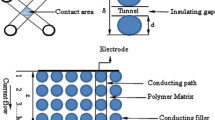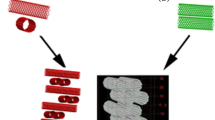Abstract
The ultimate device miniaturization would be to use individual molecules as functional devices. Single-wall carbon nanotubes (SWNTs) are promising candidates for achieving this: depending on their diameter and chirality, they are either one-dimensional metals or semiconductors1,2. Single-electron transistors employing metallic nanotubes3,4 and field-effect transistors employing semiconducting nanotubes5 have been demonstrated. Intramolecular devices have also been proposed which should display a range of other device functions6,7,8,9,10,11. For example, by introducing a pentagon and a heptagon into the hexagonal carbon lattice, two tube segments with different atomic and electronic structures can be seamlessly fused together to create intramolecular metal–metal, metal–semiconductor, or semiconductor–semiconductor junctions. Here we report electrical transport measurements on SWNTs with intramolecular junctions. We find that a metal–semiconductor junction behaves like a rectifying diode with nonlinear transport characteristics that are strongly asymmetric with respect to bias polarity. In the case of a metal–metal junction, the conductance appears to be strongly suppressed and it displays a power-law dependence on temperatures and applied voltage, consistent with tunnelling between the ends of two Luttinger liquids. Our results emphasize the need to consider screening and electron interactions when designing and modelling molecular devices. Realization of carbon-based molecular electronics will require future efforts in the controlled production of these intramolecular nanotube junctions.




Similar content being viewed by others
References
Wildöer,J. W. G., Venema,L. C., Rinzler,A. G., Smalley,R. E. & Dekker,C. Electronic structure of atomically resolved carbon nanotubes. Nature 391, 59 –62 (1998).
Odom,T. W., Huang,J., Kim,P. & Lieber,C. M. Atomic structure and electronic properties of single-walled carbon nanotubes. Nature 391, 62–64 ( 1998).
Tans,S. J. et al. Individual single-wall carbon nanotubes as quantum wires. Nature 386, 474–477 ( 1997).
Bockrath,M. et al. Single-electron transport in ropes of carbon nanotubes. Science 275, 1922–1925 ( 1997).
Tans,S. J., Verschueren,A. R. M. & Dekker, C. Room-temperature transistor based on a single carbon nanotube. Nature 393, 49– 52 (1998).
Chico,L., Crespi,V. H., Benedict,L. X., Louie,S. G. & Cohen,M. L. Pure carbon nanoscale devices: Nanotube heterojunctions. Phys. Rev. Lett. 76, 971 –974 (1996).
Lambin,Ph., Fonseca,A., Vigneron,J. P., Nagy,J. B. & Lucas,A. A. Structural and electronic properties of bent carbon nanotubes. Chem. Phys. Lett. 245, 85–89 (1995).
Saito,R., Dresselhaus,G. & Dresselhaus, M. S. Tunnelling conductance of connected carbon nanotubes. Phys. Rev. B 53, 2044– 2050 (1996).
Charlier,J.-C., Ebbesen,T. W. & Lambin, Ph. Structural and electronic properties of pentagon-heptagon pair defects in carbon nanotubes. Phys. Rev. B 53, 11108–11113 (1996).
Menon,M. & Srivastava,D. Carbon nanotube “T junctions”: Nanoscale metal-semiconductor-metal contact devices. Phys. Rev. Lett. 79, 4453–4456 ( 1997).
Chico,L., López Sancho,M. P. & Muñoz,M. C. Carbon-nanotube-based quantum dot. Phys. Rev. Lett. 81, 1278–1281 (1998).
Iijima,S., Brabec,C. J., Maiti,A. & Bernholc,J. Structural flexibility of carbon nanotubes. J. Chem. Phys. 104, 2089–2092 (1996).
Yakobson,B. I., Brabec,C. J. & Bernholc, J. Nanomechanics of carbon tubes: Instabilities beyond the linear response. Phys. Rev. Lett. 76, 2511–2514 (1996).
Collins,P. G., Zettl,A., Bando,H., Thess,A. & Smalley,R. E. Nanotube nanodevice. Science 278, 100–103 (1997).
Chico,L., Benedict,L. X., Louie,S. G. & Cohen,M. L. Quantum conductance of carbon nanotubes with defects. Phys. Rev. B 54, 2600–2606 ( 1996).
Bockrath,M. et al. Luttinger-liquid behaviour in carbon nanotubes. Nature 397, 598–601 ( 1999).
Egger,R. & Gogolin,A. Effective low-energy theory for correlated carbon nanotubes. Phys. Rev. Lett. 79, 5082 –5085 (1997).
Kane,C., Balents,L. & Fisher,M. P. A. Coulomb interactions and mesoscopic effects in carbon nanotubes. Phys. Rev. Lett. 79, 5086– 5089 (1997).
Fisher,M. P. A. & Glazman,L. I. in Mesoscopic Electron Transport (eds Kouwenhoven, L. P., Sohn, L. L. & Schön, G.) 331–373 (Kluwer Academic, Boston, 1997).
Acknowledgements
We thank R. E. Smalley and co-workers for providing the indispensable single-wall carbon nanotube materials, M. P. Anantram, S. J. Tans and A. A. Odintsov for helpful discussions, V. Meunier for the atomic coordinates used in Fig. 1c, and M. de Jonge and A. van den Enden for experimental assistance. The work was supported by the Dutch Foundation for Fundamental Research on Matter (FOM).
Author information
Authors and Affiliations
Corresponding author
Supplementary Information
Rights and permissions
About this article
Cite this article
Yao, Z., Postma, H., Balents, L. et al. Carbon nanotube intramolecular junctions. Nature 402, 273–276 (1999). https://doi.org/10.1038/46241
Received:
Accepted:
Issue Date:
DOI: https://doi.org/10.1038/46241
- Springer Nature Limited
This article is cited by
-
Investigation on electrical, structural, magnetic, optical properties and EPR studies of CdCu2O3 composite oxide prepared via sol–gel method
Indian Journal of Physics (2024)
-
A robust and tunable Luttinger liquid in correlated edge of transition-metal second-order topological insulator Ta2Pd3Te5
Nature Communications (2023)
-
Evidence for two dimensional anisotropic Luttinger liquids at millikelvin temperatures
Nature Communications (2023)
-
One-dimensional Luttinger liquids in a two-dimensional moiré lattice
Nature (2022)
-
Imaging gate-tunable Tomonaga–Luttinger liquids in 1H-MoSe2 mirror twin boundaries
Nature Materials (2022)





